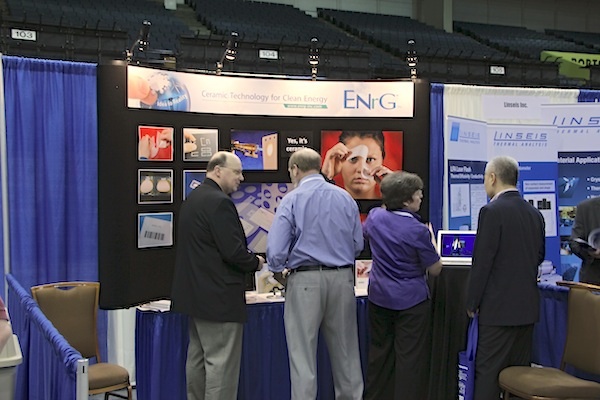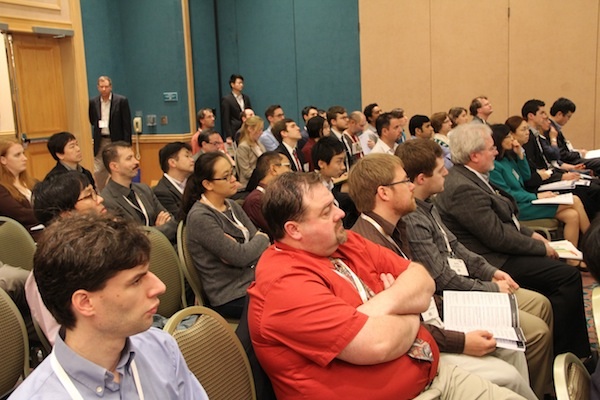
 A technical session at ICACC’13. Credit: ACerS.
A technical session at ICACC’13. Credit: ACerS.
One of the largest ACerS meetings every the year is the Engineering Ceramics Division meeting, which is officially the 38th International Conference and Expo on Advanced Ceramics and Composites, although it is often referred to simply as “the Daytona Beach meeting.” Held each January in Daytona Beach, Fla., the meeting attracts more than 1,000 attendees from around the globe. Early bird registration for ICACC’14, slated for January 26–31, runs through Dec. 19.
Sanjay Mathur, who organized the 2012 ICACC and is on this year’s organizing committee, says, “The ICACC meetings have emerged as an authentic platform to experience and enjoy the evolution of ceramics science and technology. The unique constellation of thematic areas and international gathering speaks for the high visibility and importance of this conference both for showcasing state-of-the-art scientific results as well as for building new contacts with peers worldwide.”
This is a dense meeting: plenary and award speakers, 13 technical symposia, four focus sessions, a Global Young Investigators Forum, 2nd Pacific Rim Engineering Ceramics Summit, Expo, and a short course on mechanical properties. Read on for details!
A subtitle for this meeting could be “Look what ceramics can do!” The technical program covers functional and structural ceramics, processing, and applications, including topics such as armor, bioceramics, porous ceramics, ultrahigh temperature ceramics, and more. The importance of ceramics for energy generation and storage is evident in symposia on SOFC, rechargeable energy storage, and nuclear and fusion energy. Computational methods and the “Ceramic Genome” will be covered, as will advanced processing and manufacturing techniques.
Organizer Michael Halbig and his team included four “focus sessions,” which are symposia on specialized topics of emerging interest. Over the years, some of these have turned into regular symposia, but their real value is in providing a way to address rapidly developing issues. This year’s four focus sessions are
- Geopolymers, Chemically Bonded Ceramics & Eco-friendly and Sustainable Materials
- Advanced Ceramic Materials and Processing for Photonics and Energy
- Rare Earth Oxides for Energy, Optics and Biomedical Applications
- Ion-Transport Membranes.
The plenary and award speakers are always a highlight of the first day. This year is no exception, with these luminaries of the ceramics world.
- Sheldon Wiederhorn—Mueller Award, “From the Rattler Test to Modern Fracture Mechanics: A Perspective on Toughness,”
- José Varela—Bridge Building Award, “Building Bridges in Materials Science and Technology: An Important Issue for Solving Basic Problems in Modern Society,”
- Willard Cutler—Plenary speaker, “The Need and Potential of Porous Ceramic Materials,”
- Ulrich Simon—Plenary speaker, “Nanostructured Metal Oxides in Gas Sensing Applications: Challenges and Perspectives”
- Eva Hemmer—Global Young Investigator Award, “Ln3+-Doped Gd2O3 Nanostructures for NIR-NIR Bioimaging.”
The Global Young Investigators Forum is a great place to meet the rising leaders in ceramics. It is organized by Thomas Fischer from the University of Cologne, Germany, who also organized the first forum in 2012. At the 2012 ICACC he told me the goal is to engage young scientists more fully in the conference, saying “Normally at conferences you have established scientists and huge sessions, and it’s a little bit of a barrier. We wanted to lower this barrier by having a session on our own, but one where the established scientists also take part.” A second goal, he says is to create “a venue where young people can meet and try to find their own networks.”
This year’ Engineering Ceramics Summit focuses on the Pacific Rim, which is a nice follow-up to last year’s PACRIM 10 meeting in San Diego, Calif.
The Expo will welcome more than 50 vendors showcasing their products and services. Students will have their annual shot glass dropping competition (sponsored, appropriately, by Schott Glass) during the Expo.
Finally, world-renowned experts in mechanical properties, George Quinn and Richard Bradt, will wrap up the conference activities with their popular short course on mechanical properties of ceramics and glass on January 30–31. A central part of the course covers mechanical testing and interpretation of test data.
Start the new year strong! Come to Daytona Beach!
